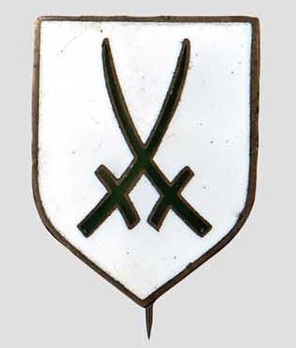RAD Arbeitsgau XV Sachsen Tradition Cap Badge
SKU: 80.GOR.03.01.02.006
Estimated market value:

Estimated market value:
Attributes
History
The RAD (Reichsarbeitsdienst = Reich Labour Service) was officially established on June 26, 1935 as the sole, and compulsory, labour service of Germany. Its purposes were to help the economy, curb unemployment, and indoctrinate its members with the NSDAP ideology, as well as play its part in militarising the German population.
The FAD (Freiwilliger Arbeitsdienst = Voluntary Labour Service) was the precursor of the RAD in the early 1930s. Official uniform regulations were first introduced on October 1, 1933, with modifications made in July 1934. It is also known as NSAD (Nationalsozialistischer Arbeitsdienst = National Socialist Labour Service).
The earliest uniforms were a not entirely successful attempt at standardisation. They gave way to a second wave of FAD uniforms that, when the RAD was established, experienced no significant changes.
Tradition Cap Badges were worn by 17 out of the 40 Arbeitsgaue (labour districts). They were introduced at different times between 1934 and 1942 and worn on the left side of the RAD Cloth Cap, but not any other cap. They are made of metal, sometimes with colourful enamel.
Arbeitsgau I used a black swastika with a superimposed white with black cross Teutonic Knights Order shield.
Arbeitsgau IV used a blue and silver-coloured shield with a Pomeranian griffin.
Arbeitsgau V used a gold-coloured piece of jewelry of the Viking Hiddensee treasure.
Arbeitsgau VI used a gold-coloured sunwheel swastika with a superimposed white disc with the Mecklenburg buffalo in black, silver, and red on it.
Arbeitsgau XI used a black Silesian eagle with red claws and beak, with a silver-coloured crescent on its chest.
Arbeitsgau XV used a white shield with two crossed green swords.
Arbeitsgau XVIII used two bronze-coloured crossed beams with horse heads, with a swastika with wheat ears in between.
Arbeitsgau XXI used a silvered shield with a green enamelled spade with a black shaft at the top. It features the separated words "Nieder" and "Rhein" at the top, a white river with gold-coloured borders diagonally crossing the spade, and a black Schlageter cross inside a white circle, all with gold-coloured borders, on the upper right side. The left and right edge of the shield are covered by gold-coloured wheat sheafs, with a black mobile swastika at the bottom.
Arbeitsgau XXII used an oak twig with leaves and acorns.
Arbeitsgau XXVII used a silver-coloured spruce twig with needles and fir cones.
Arbeitsgau XXIX used a blue and white oval shield depicting the Befreiungshalle (Hall of Liberation) near Kelheim.
Arbeitsgau XXX used a brown oval shield with two flowers, both with green stems, a white and gold-coloured edelweiss and a blue gentian.
All four Arbeitsgaue of Austria used an either silver-coloured or gold-coloured edelweiss flower.
The Arbeitsgau Sudetengau-Ost was later renamed Böhmen-Mähren (Bohemia-Moravia). It used a red shield depicting the Prague Roland statue on the Charles Bridge, both silver-coloured, with grey waves underneath and two coats of arms at the top, in black and red.


Comments
Sign in to comment and reply.


Scroll Top